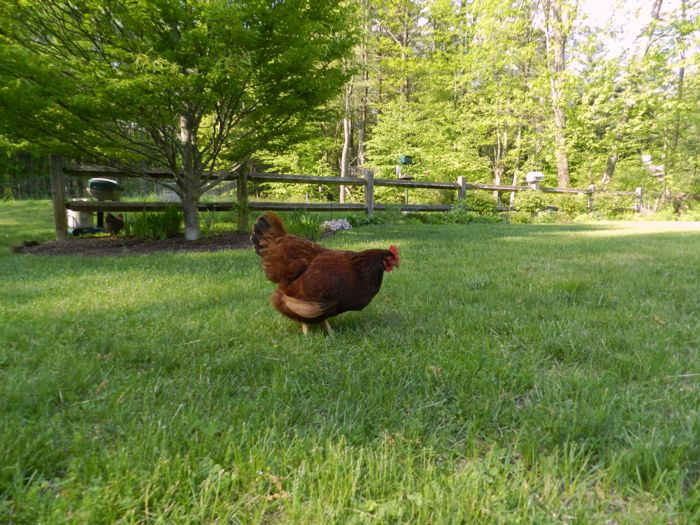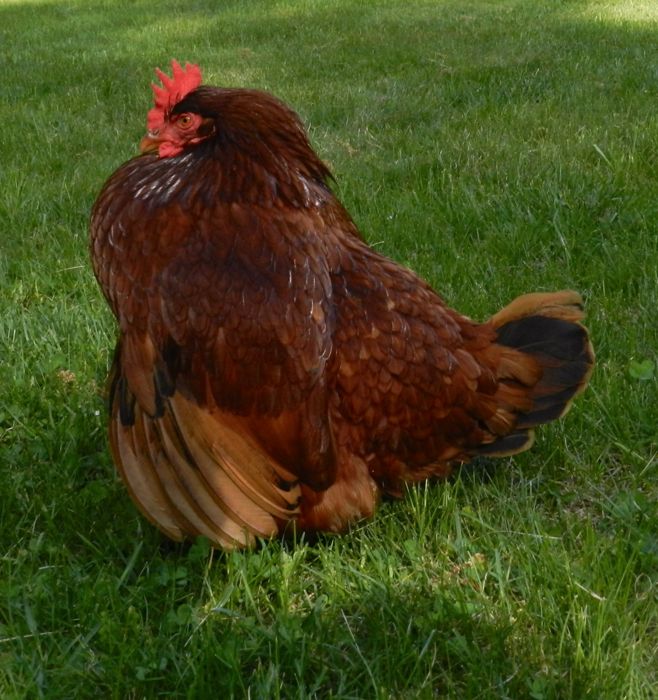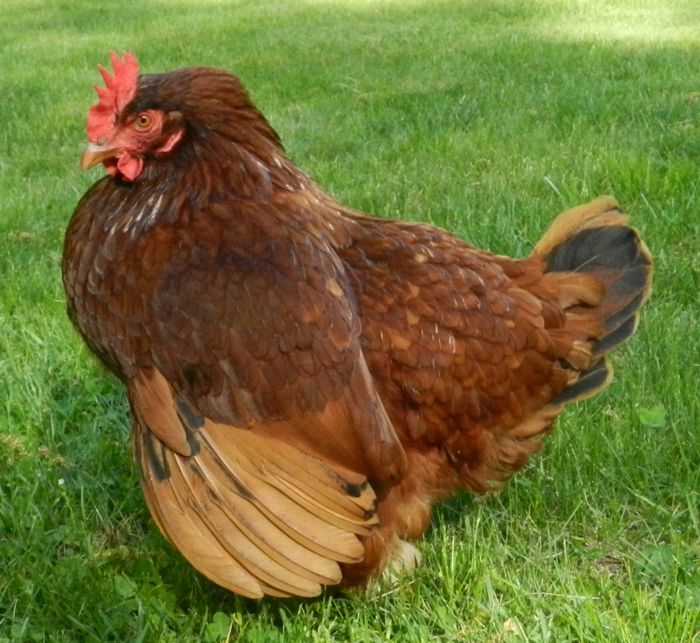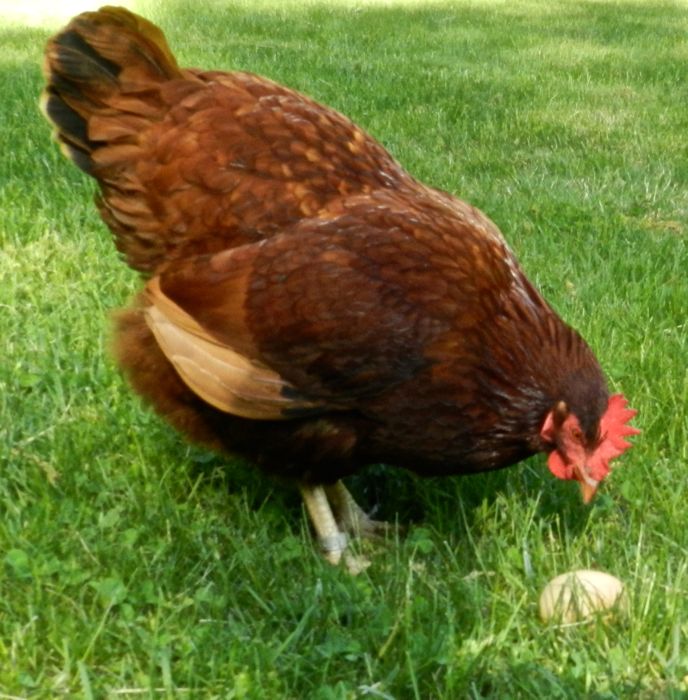The other day I let the Gems out on the lawn. I noticed that Ruby did not look right. She was huffed up and her wing feathers drooped down.
As I watched, she became more distressed.
And then the reason for her extreme discomfort became obvious. She laid an egg with a shell that was soft like a thin balloon. A hard and smooth egg slips right out of the hen’s vent, but it is quite difficult to push one out that is rough, squishy and pliant.
Once out, that soft-shelled egg is easy to eat – which Ruby turned around to do. I didn’t want her to eat that egg, because once a hen learns that her eggs are edible, it is the beginning of a bad habit, one in which she breaks even the hard-shelled eggs in order to eat them. I snatched the egg away from her.
Without the egg in front of her, and with the relief of no longer straining to lay, she went off to forage with the other hens.
Why do hens lay these soft-shelled eggs? Elderly hens, like Twinkydink, lay thin-shelled eggs. That’s because their systems are depleted of calcium, and their old bodies, even when fed the right foods, can no longer form a thick shell. That’s different than the membrane-enclosed egg that Ruby laid.
It takes about twenty-six hours for a hen to build an egg in her reproductive tract. Laying on the shell takes a big chunk of that time. If the hen is stressed and the process is interrupted, the shell can be thin or rubbery. It’s something to consider when you find a soft-shelled egg, but usually, the cause of those odd eggs is poor nutrition.
My hens get laying hen pellets that contain calcium, and also have oyster shell free choice. I provide her with granite grit so that she can grind up and digest this food. A two-year old hen, like Ruby, should be able to get all of the minerals she needs from such a diet, and lay sturdy eggs. She usually does. But, the other day I had a big bowl of leftover spaghetti. Divided between the ten Gems (and Siouxsie) it should have made a fine treat. However, I believe that Ruby, being a gluttonous Rhode Island Red, ate more than her share, which upset her fine-tuned nutritional balance, and she didn’t have the necessary materials to make a normal eggshell.
The day after laying this “rubber” egg, Ruby laid a thin-shelled egg in the nesting box. Since then, all of the eggs that I’ve collected from the Gems have looked normal. I believe that Ruby is laying thick-shelled eggs again, but since I’m not outside all of the time, I’m not 100% sure. I haven’t seen any egg eating, so that’s a relief.
The Gems won’t be getting spaghetti anytime soon.





Good info. May I ask what kind of layer feed you use? Would like to use it for my hens when it’s time. Love the RIR deep rust colors.
interesting to read – I’ve been dealing with 2 of my 2 year old ladies who have been laying soft-shelled eggs for some time now – they are the only ones doing so, out of the 7, but its been pretty strange. I’ve been feeding them an organic whole grain feed, but I’ve really wondered if they’ve been getting the more powdery part of the mix that has all the minerals. Been thinking of switching to a pellet, but hate to give up the organic feed – but if this is the cause, it seems like I have no choice. Both these girls tend to lay off the roost in the early morning, but then I’ll find them in the nest boxes as well, rarely laying an egg, but even so, it is soft, so maybe an inclusive pellet would do the job?
I feed laying hen pellets. Either nutrena (when I have $ off coupons) or Purina layena. I like the pellets. Very little waste. Hens will eat what they want from whole grain, and it’s likely yours are eating the less nutritious grains (corn, for example) and not getting what they need.
Thanks Terry – there’s no corn or soy in our organic feed (it’s whole oats, crushed pigeon peas, and BOSS plus the fertrell minerals) but I think you’re right – they pick through and get what they want, and leave the minerals. Guess I’ll have to reconsider. At least they free-range almost daily, so hopefully it has amped up their general health. Appreciate your input!
Much appreciated. I will get the layena pellets. My store has that brand.
I learn the coolest things here!
Whats with spaghetti
Feeding spaghetti is like giving your hens junk food – lots of carbs, but nothing that they need to do the hard work that they do of laying eggs.
It also looks like worms and they love it…Terry..I have been giving the girls plain yogurt about 3 times a week…just a good sozed glob in each of their bowls….is this ok? They LOVE it…P.S. Did you get the feed bags?
It also looks like worms and they love it…Terry..I have been giving the girls plain yogurt about 3 times a week…just a good sized glob in each of their bowls….is this ok? They LOVE it…P.S. Did you get the feed bags?
That is food for the thought. I have only one hen…Julie the Barred rock(who is just a year old), that sometimes lays a soft-shelled egg. She has not had any for 3 weeks or so and when I think about it, I have not given the girls any pasta in that period. In fact I have really slowed down on giving them any snacks other then left-over yogurt. Luckily none of the Hens ate any of those eggs.
A Barred Rock that is only one year old should be laying at least 4 eggs weekly, so I’d say something is amiss.
Hi Terry…..She is laying 5 or 6 eggs a week and big eggs. but she sometimes( not often) was laying soft-shell. I think it was in apr that she did it 3 days in a row but she has not had any for 3 weeks or so. It was around that time I had a bag of layer crumbles too that was different for the hens, so whether that had something to do with it…who knows? She is acting like a normal hen other-wise and a joy.
Maybe I should specify, They have always had pellets before and since. :)
Hi Terry! Good stuff, great and informational post. I feed my girls Layena, as it has the calcium plunked right in it. I also dress it with oyster shell for good measure. I try other formulas, and I keep going back to Layena. I too am prone to spoiling my girls with junk food( brought home hamburger buns) but it’s only when they’ve been really good and haven’t done too much destruction to the garden. When the ladies DO make a thin shelled egg I scramble it for them with a little olive oil and feed it back to them. Shells mashed up in it. They seem to not recognize it as THEIR egg but as a Dad special treat.
Great info! And pretty lawn! :)
I have a 2 year old Gold Laced Wyandotte that produces a shell-less egg every so often. She’s the most prolific layer of the bunch, but sometimes I find a no shell egg or just a thin membrane under the roost in the morning. Not like Ruby’s which looks like it held it’s egg shape. She’s the only hen (of 6) that I’ve noticed this with. They do love the compost bin in the run, so maybe she is eating more of that like you said. Good info!
Also, these no shell eggs are always under the roost. She’s never laid one of these in a nest box. Hmmm….
Paul, I think that because the soft eggs are so uncomfortable to lay, that the hen needs to move about while doing it. That’s why she doesn’t lay them in the nesting box.
Ahhhh… Thanks Terry. I meant to say she DROPS them from the roost at night. But your theory sounds like the right answer. More sleuthing!
Hi Terry. Thanks for your comments about my 14 month old BR, Scarlett, who is laying rubber and thin-shelled eggs. We feed our 3 hens organic layer pellets and have grit and oyster shell/crushed egg shell available. They get to free-range in our yard evenings and weekends. I do like to give them treats like oatmeal and quinoa with yogurt on cold days and melon on hot days. They love bananas. I’m having an infestation of earwigs right now so I collect them at night and let the girls have them in the morning. I also usually put some greens in their run during the week when we are at work. After getting 2 rubber eggs last week, we gave Scarlett and Henny the spa treatment and we got 3 regular eggs for each of the next two days. Then today Scarlett laid a thin-shelled egg from the roost which broke but it doesn’t look like they ate any of it, thank goodness. We’ve had some 20-30 degree swings in daytime temps over the past month. Yesterday it was 90 and today should be 70. How much oatmeal is too much? They share about a half cup to a whole cup and I know that the BRs are getting a larger share than the EE because they are more aggressive. Thanks for all of the information you put on your blog…you’re my first go-to for help. And I love to see how Buffy and Twinkydink are surviving the young ones!
The best layers have the hardest time keeping their protein and mineral intake properly balanced. At the first sign of thin-shelled eggs, I’d skip all of the extra grains, like oatmeal, as that dilutes the amount that they eat of the stuff they really need. In any event, 1 cup of oatmeal for 3 hens is too much, even if they are laying properly.
Thanks, Terry! I’ll cut out the oatmeal and see if there is an improvement. She is a really great layer of medium sized eggs. Before this spate of inconsistency, she was usually 28-29 per month!
Last night instead of scratch I gave them layer pellets as a treat and they gobbled them up. But I got another broken shell-less egg under their night roost this morning. :-(
It will take a few days. Remember that it takes about 26 hours to form an egg. Also, do you feed free choice? Your hens should have pellets available all day long.
They do have pellets, grit, and eggshell/oyster shell available free choice. They free range around the yard 2-3 hours per day and I try to make sure that they eat some pellets before roosting at night. Thanks, Terry!
I have to be careful too with only two full grown hens and two pullets to make sure I am not giving too many treats.
I’m worried. Thought I had and egg bound RRR. Droopy eyes, tail bobing on the nest. Walking alittle tippsy. Gave her the spa treatment in the warm water. She enjoyed it but no egg. Took her out of the coop. 2 roosters trying to mate with her in her weekened condition. She still sits and bobs her tail. I checked inside went full finger length with nothingin the way. after the spa she passed a big BM and is still passing smaller feces but no egg and still seems sick. Gave her some dried meal worms ate them fast. and 1 ml of poultry Nutri-drench orally. This besides offering regular diet of scratch,layer crumble. oyster shell, grit and free range 7 days a week. Water always available. not given any antibiotics. dont know what to give or where to get it. Help
Those external symptoms and behavior are indicative of many ailments. The spa treatment helps for blockages (not caused by tumors), mineral imbalances and clearing out toxins that a hen might have ingested. If it doesn’t work she could have cancer, tumors, ascites, or peritonitis. She could be an internal layer. I’ve seen all of these things, and only know what it is after a necropsy. If the spa treatment didn’t work, then a last-chance might be antibiotics, like duramycin. If she has an internal infection it *might* help.
force feeding some now layer crumble and yogart h2o with electeolyes and probiotics. still lethargic. head moving, looks like she is reading right to left. eyes look dialated. still has some fight in her but not moving around much. vet wont give atibiotic without exam. any over the counter? she was a good layer until past week
I don’t believe in force feeding. Often, a hen that stops eating has stopped for a very good reason – perhaps cancer or a blocked intestinal tract.
BTW thanks for responding. im not very computer savvy